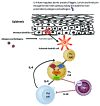The involvement of the JAK-STAT signaling pathway in chronic inflammatory skin disease atopic dermatitis
- PMID: 24069552
- PMCID: PMC3772104
- DOI: 10.4161/jkst.24137
The involvement of the JAK-STAT signaling pathway in chronic inflammatory skin disease atopic dermatitis
Abstract
Atopic dermatitis (AD), a common chronic inflammatory skin disease, is characterized by inflammatory cell skin infiltration. The JAK-STAT pathway has been shown to play an essential role in the dysregulation of immune responses in AD, including the exaggeration of Th2 cell response, the activation of eosinophils, the maturation of B cells, and the suppression of regulatory T cells (Tregs). In addition, the JAK-STAT pathway, activated by IL-4, also plays a critical role in the pathogenesis of AD by upregulating epidermal chemokines, pro-inflammatroy cytokines, and pro-angiogenic factors as well as by downregulating antimicrobial peptides (AMPs) and factors responsible for skin barrier function. In this review, we will highlight the recent advances in our understanding of the JAK-STAT pathway in the pathogenesis of AD.
Keywords: JAK-STAT; Th2; atopic dermatitis; inflammation; skin.
Figures


Similar articles
-
Potential Natural Biomolecules Targeting JAK/STAT/SOCS Signaling in the Management of Atopic Dermatitis.Molecules. 2022 Jul 21;27(14):4660. doi: 10.3390/molecules27144660. Molecules. 2022. PMID: 35889539 Free PMC article. Review.
-
The JAK/STAT Pathway and Its Selective Inhibition in the Treatment of Atopic Dermatitis: A Systematic Review.J Clin Med. 2022 Jul 29;11(15):4431. doi: 10.3390/jcm11154431. J Clin Med. 2022. PMID: 35956047 Free PMC article. Review.
-
Mesenchymal Stem Cells and Extracellular Vesicles Derived from Canine Adipose Tissue Ameliorates Inflammation, Skin Barrier Function and Pruritus by Reducing JAK/STAT Signaling in Atopic Dermatitis.Int J Mol Sci. 2022 Apr 27;23(9):4868. doi: 10.3390/ijms23094868. Int J Mol Sci. 2022. PMID: 35563259 Free PMC article.
-
A novel, topical, nonsteroidal, TRPV1 antagonist, PAC-14028 cream improves skin barrier function and exerts anti-inflammatory action through modulating epidermal differentiation markers and suppressing Th2 cytokines in atopic dermatitis.J Dermatol Sci. 2018 Apr 30:S0923-1811(18)30204-4. doi: 10.1016/j.jdermsci.2018.04.017. Online ahead of print. J Dermatol Sci. 2018. PMID: 29752146
-
Off-label use of Baricitinib improves moderate and severe atopic dermatitis in China through inhibiting MAPK and PI3K/Akt/mTOR pathway via targeting JAK-STAT signaling of CD4+ cells.Front Pharmacol. 2024 Feb 29;15:1324892. doi: 10.3389/fphar.2024.1324892. eCollection 2024. Front Pharmacol. 2024. PMID: 38487164 Free PMC article.
Cited by
-
Protective effects of Astragaloside IV against oxidative injury and apoptosis in cultured astrocytes by regulating Nrf2/JNK signaling.Exp Brain Res. 2021 Jun;239(6):1827-1840. doi: 10.1007/s00221-021-06096-7. Epub 2021 Apr 8. Exp Brain Res. 2021. PMID: 33830313
-
Cheungsam Seed Husk Extract Reduces Skin Inflammation through Regulation of Inflammatory Mediator in TNF-α/IFN-γ-Induced HaCaT Cells.Plants (Basel). 2024 Jun 19;13(12):1704. doi: 10.3390/plants13121704. Plants (Basel). 2024. PMID: 38931136 Free PMC article.
-
Effect of Cone of Pinus densiflora on DNCB-Induced Allergic Contact Dermatitis-Like Skin Lesion in Balb/c Mice.Nutrients. 2021 Mar 4;13(3):839. doi: 10.3390/nu13030839. Nutrients. 2021. PMID: 33806628 Free PMC article.
-
Pruritus in allergy and immunology.J Allergy Clin Immunol. 2019 Aug;144(2):353-360. doi: 10.1016/j.jaci.2019.06.016. J Allergy Clin Immunol. 2019. PMID: 31395149 Free PMC article. Review.
-
Tofacitinib and metformin reduce the dermal thickness and fibrosis in mouse model of systemic sclerosis.Sci Rep. 2022 Feb 15;12(1):2553. doi: 10.1038/s41598-022-06581-1. Sci Rep. 2022. PMID: 35169250 Free PMC article.
References
Publication types
LinkOut - more resources
Full Text Sources
Other Literature Sources
